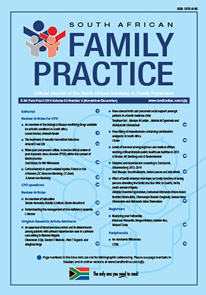Diabetes and hypertension screening in Zandspruit, Johannesburg 2012–2014
Keywords:
diabetes mellitus, hypertension, obesity, screening, South Africa
Abstract
Background: Hypertension (HT) and diabetes mellitus (DM) affect millions of individuals in South Africa and are among the leading causes of morbidity and mortality. Given the substantial public health and socio-economic burden South Africa faces due to the rising rates of chronic diseases, prevention strategies with community engagement may play a vital role in controlling these diseases and their associated sequelae. Objectives and methods: Project HOPE, an implementing partner of the Lilly Non Communicable Disease (NCD) Partnership programme in South Africa, conducted screening days and home visits as part of a non-communicable disease awareness campaign in the Zandspruit suburb of western Johannesburg (lower income, informal settlement). Standardised assessment tools were used, which included glucose and blood pressure measurement. Results: Of 7607 participants screened, 2773/7470 (37.1%) of those with blood pressure values could be classified as hypertensive with systolic blood pressure (BP) ≥ 140 mmHg or diastolic BP ≥ 90 mmHg. Of the 7607 glucose screened individuals, 630 (8.3%) had referable random capillary glucose levels ≥ 7.8 mmol/l. There was a clear gradient of increased prevalence over age and body mass index (BMI) categories. Conclusions: In this urban low-income suburb hypertension was common with hyperglycaemia less so. The number of participants returning to the clinic for confirmation of diagnoses was less than optimal and highlights the problem of community-based screening. (Full text of the research articles are available online at www.medpharm.tandfonline.com/ojfp) S Afr Fam Pract 2016; DOI: 10.1080/20786190.2016.1198089
Published
2016-12-07
Section
Research Articles
By submitting manuscripts to SAFP, authors of original articles are assigning copyright to the South African Academy of Family Physicians. Copyright of review articles are assigned to the Publisher, Medpharm Publications (Pty) Ltd, unless otherwise specified. Authors may use their own work after publication without written permission, provided they acknowledge the original source. Individuals and academic institutions may freely copy and distribute articles published in SAFP for educational and research purposes without obtaining permission.

